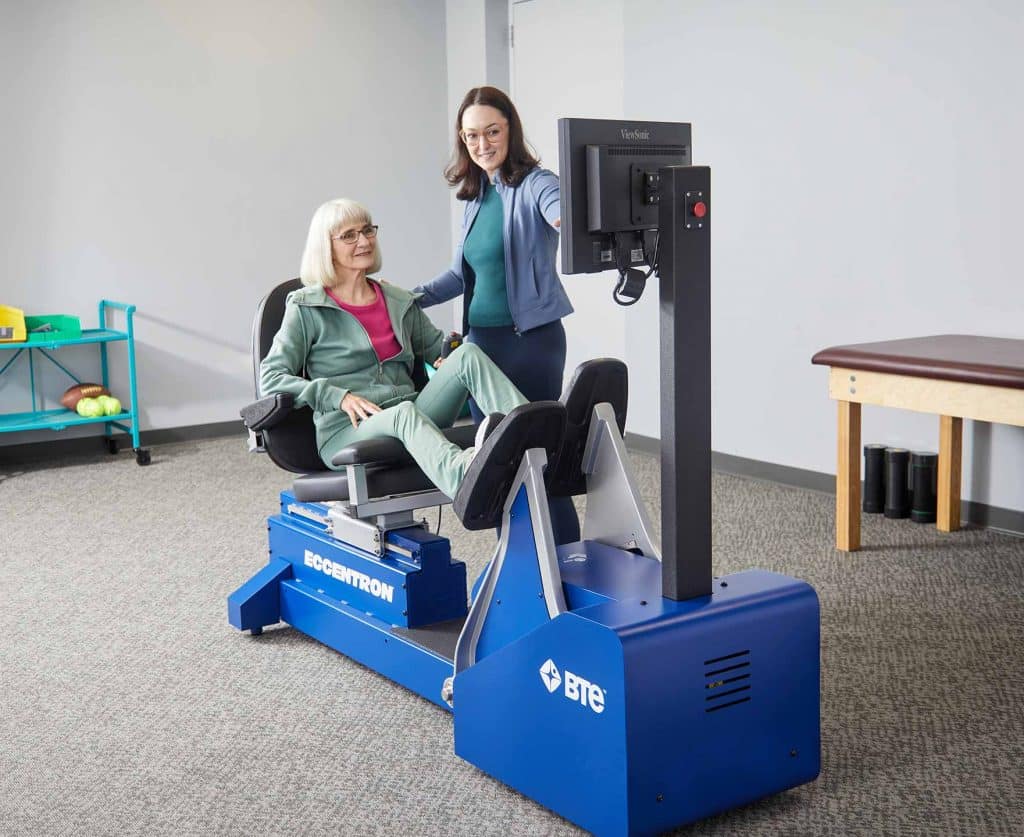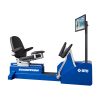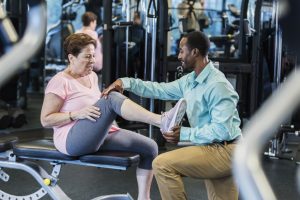
Improving Ambulation in Spinal Cord Injury Rehab
Clinical ResearchDiscover how eccentric training enhances mobility and independence in spinal cord injury rehabilitation. Learn about the latest research, key exercises, and the role of the Eccentron in boosting muscle activation, force production, and functional abilities for your SCI patients.
Ambulation and mobility are often the biggest challenges in spinal cord injury rehabilitation. As physical therapists, we know that our patients often face significant physical challenges following a spinal cord injury (SCI). The road to recovery can be long and arduous, with loss of muscle mass, impaired function, and decreased mobility taking a toll on their independence and quality of life. The ability to walk is not just about movement; it’s about regaining control over one’s environment and life.
A recent study measured lower extremity muscle activation, force production, and functional abilities in adults with incomplete SCI (iSCI). Study participants completed a specialized physical therapy treatment program focusing on eccentric training. The results after the intervention revealed major improvements in all three areas, crucial for overall mobility and independence.1
Keep reading for a summary of this clinical study, its encouraging results, and how you can significantly increase your patients’ muscle activation, force production, and functional abilities. This evidence-based physical therapy treatment can help you improve ambulation in spinal cord injury rehab.
The Importance of Lower Extremity Strengthening
We know how critical lower extremity strength is for increasing mobility and independence in spinal cord injury rehabilitation. Strong leg muscles are essential for transfers, standing, and walking. However, strengthening these muscles in individuals with neurological conditions presents unique challenges, including:
- Limited motor control
- Muscle spasticity
- Decreased sensation
- Reduced cardiovascular endurance
Despite these challenges, a new study has demonstrated positive outcomes with eccentric-focused training in SCI rehabilitation.1
Evaluating Ambulation in Spinal Cord Injury Rehab
To assess progress in ambulation of SCI patients, we commonly use the following assessments:
- Timed Up and Go (TUG) Test: Measures the time it takes for a patient to stand up from a chair, walk 3 meters, turn around, walk back, and sit down.
- 10-Meter Walk Test: Assesses walking speed over a short distance, providing insight into functional mobility.
- Walking Index for Spinal Cord Injury (WISCI): A 21-level scale that evaluates walking capacity based on the need for physical assistance, braces, and devices.
- Spinal Cord Independence Measure (SCIM):A comprehensive assessment of function in individuals with SCI, including a subsection on mobility.
New Research: Eccentric Training in SCI Rehabilitation
Eccentric training has long been regarded as one of the most effective ways to build muscle with minimal strain on the body. Intrigued by its potential, researchers sought to determine its efficacy in a spinal cord injury population. A recent study by Stone et al. (2019) evaluated the impact of eccentric resistance training on physical function and ambulation in spinal cord injury patients.1
The study focused on participants with chronic incomplete SCI who had plateaued in their recovery using traditional rehabilitation methods. The exercise protocol consisted of a 12- week eccentric-focused resistance training program using a specialized device that isolates eccentric contractions of the lower extremities. Participants engaged in training sessions twice a week.
The researchers measured several key aspects of physical function and mobility:
- Walking mobility: Assessed using the Timed Up and Go (TUG) test.
- Walking speed: Evaluated using the 10-meter walk test.
- Walking capacity and independence: Measured using the Walking Index for Spinal Cord Injury (WISCI).
- Overall function: Assessed using the Spinal Cord Independence Measure (SCIM).
Baseline measurements were taken before training, with follow-up assessments conducted after the 12-week intervention period. This comprehensive approach allowed the researchers to evaluate not just changes in walking ability, but also improvements in overall function and independence, providing a more holistic view of the intervention’s effects.
The results of the study were highly encouraging, showing enhanced ambulation in the spinal cord injury patients:
- Improved walking mobility: Participants showed a significant decrease in the time needed to complete the Timed Up and Go (TUG) test, indicating substantial improvement in functional mobility.
- Increased walking speed: The 10-meter walk test revealed a marked increase in walking speed post-intervention, suggesting enhanced locomotor function.
- Enhanced independence: WISCI scores demonstrated a notable improvement, reflecting increased walking capacity and greater independence in mobility tasks.
These results demonstrate significant improvements in ambulation, independence, and overall function for individuals with incomplete SCI. The study suggests that eccentric resistance training can be a valuable tool in SCI rehabilitation, potentially helping patients break through plateaus in their recovery and achieve meaningful gains in mobility and independence.
Why Eccentrics?
Understanding the difference between concentric and eccentric muscle contractions is key to grasping the full potential of eccentric exercises in SCI rehabilitation.
Concentric movement occurs when a muscle shortens as it generates force and contracts. For example, when you climb stairs, your quadriceps muscles contract concentrically to extend your knee and lift your body. Eccentric movement happens when a muscle lengthens under tension. For instance, when you descend stairs, your quadriceps muscles contract eccentrically to control the knee flexion and lower your body against gravity. Eccentric exercise offers several unique benefits that make it particularly suitable for spinal cord injury rehabilitation:
- Lower energy requirements: Eccentric contractions are inherently more energy efficient than concentric contractions. This efficiency stems from the ability of muscles to store and utilize elastic energy during lengthening, significantly reducing the overall metabolic cost. As a result, eccentric exercises demand less cellular energy (ATP). 2,3 This is particularly beneficial for SCI patients who often have decreased cardiovascular endurance.
- Lower oxygen consumption: Eccentric exercise requires less oxygen than concentric exercise for the same amount of mechanical work. 2,3 This lower oxygen demand is advantageous for SCI patients, especially those with higher-level injuries who may have compromised respiratory function.
- Lower perceived exertion: This makes eccentric exercise more tolerable for deconditioned or atrophied limbs, which is often the case in SCI rehab. 3 The reduced perceived effort can help patients engage in longer training sessions and potentially see faster progress.
- Safer for cardiac limitations: The lower oxygen requirement and reduced cardiovascular stress make eccentric exercise a safer option for SCI patients unable to tolerate intense cardiovascular exercise. 3
- Efficient muscle building: Researchers have long regarded eccentric exercise as one of the most efficient ways to build muscle in the lower extremities. 3 This is crucial for SCI patients who often experience significant muscle atrophy below the level of injury.
- Enhanced neuromuscular control: Eccentric training has been shown to improve motor control and coordination, essential for SCI patients working to regain functional mobility. 4
Among rehabilitation devices, the Eccentron stands out as the sole apparatus that fully capitalizes on these eccentric training benefits. By exclusively targeting eccentric contractions in the lower extremities, it offers a unique advantage in rehabilitation. The Eccentron goes beyond facilitating exercise; it provides a wealth of objective data on user performance. Its automated reporting system generates detailed insights on crucial metrics. These include maximum and average force production, accuracy in meeting target forces, bilateral strength comparisons, and progress tracking across sessions.
This combination of focused eccentric training and comprehensive data collection has made the Eccentron a preferred tool among researchers studying lower extremity rehabilitation and performance optimization. Its gentle yet effective exercise and detailed reporting made it the ideal research tool for the study on improving ambulation in spinal cord injury rehab.

Isolating Eccentric Contractions in Rehab
While the benefits of eccentric training for improving ambulation in spinal cord injury rehab are clear, it’s nearly impossible to truly isolate eccentric contractions without specialized equipment. Most traditional approaches still involve concentric contractions and may not be as engaging for SCI patients who often face a long recovery period. The most effective way to isolate eccentric contractions is with the Eccentron, which not only focuses solely on eccentric movements but also features a gaming interface that makes the exercises fun and engaging.
Recent research has shown that specialized eccentric training devices can produce significantly higher muscle activation compared to other eccentric exercises. A study by Petrofsky et al. (2019) found that the Eccentron achieved up to four times the muscle activation of other eccentric exercises. 5 In this comparative study, researchers observed that the Eccentron produced an average muscle activation of 60% of participants’ maximum, substantially outperforming traditional exercises.
In spinal cord injury rehab and any physical rehabilitation program, our patients want to see improvement as soon as possible. By maximizing the efficiency of lower extremity exercise with Eccentron, you’ll put your patients on the best path to recovery. With the encouraging results of this SCI study, Eccentron is a functional, objective, and engaging evidence-based treatment to improve ambulation in spinal cord injury rehab.
Conclusion
As physical therapists, we are constantly seeking evidence-based approaches to improve ambulation and independence for our patients with spinal cord injuries. The emerging research on eccentric training offers a promising avenue for enhancing ambulation, strength, and independence in the SCI population.
By incorporating eccentric-focused exercises into our spinal cord injury rehabilitation programs, we can potentially accelerate progress, improve functional outcomes, and enhance our patients’ quality of life. The field of SCI rehabilitation is evolving, and eccentric training represents an exciting development in our quest to help patients regain mobility and independence.
At BTE, we promote evidence-based treatment with our physical therapy equipment like the Eccentron. With the Eccentron, you tap into all the musculoskeletal and neurological benefits of eccentric training. Appropriate for geriatrics to athletics, it’s one device that delivers engaging, research-proven treatment for your whole practice. Plus, the automated objective progress reports make it easy to track and share progress with patients and referrers. Interested in the Eccentron for your practice? Get a quote today.
Get a Quote
Hannah le Roux, OTR/L, CHT, is an experienced Occupational Therapist and Certified Hand Therapist with over two decades of international practice across South Africa, the United Kingdom, and the United States. Now, Hannah leverages her extensive expertise as a consultant, guiding fellow therapists in clinical patient care strategies and authoring insightful articles.






